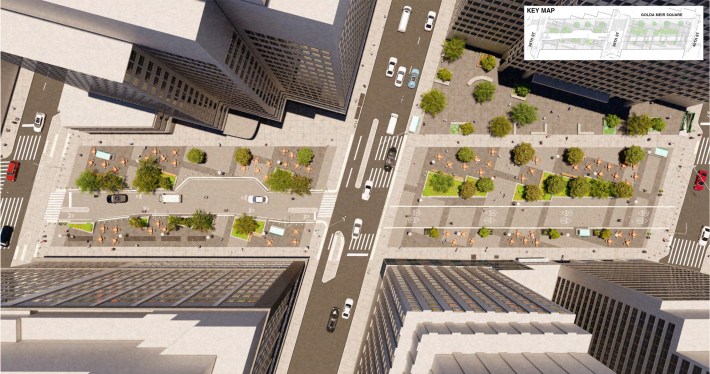A pair blocks on Broadway in Midtown will become permanent bike and pedestrian spaces, the first major reconstruction along the Manhattan corridor since the Bloomberg administration kicked cars out of Times Square.
The city painted a plaza on Broadway between 39th and 40th streets and created a shared street configuration on the block south of W. 39th Street three years ago, which officials plan to transform with concrete to be level with the curb, Department of Transportation reps told the Community Board 5 Transportation Committee on Monday.
"We’re really looking to create a premier public space," DOT's Public Realm Unit Acting Design and Capital Lead Casey Gorrell told the committee. "We are essentially starting from a clean slate, because we’re doing a capital reconstruction, so we’re able to really take advantage of narrowing the roadway substantially to calm traffic and reduce volume."
The overhaul is part of DOT's Broadway Vision that has been improving the marquee corridor for a decade-and-a-half between Times and Union squares, and the agency is laying the groundwork to replace more of its recent painted designs with harder infrastructure, together with the Department of Design and Construction.
"We’re using a lot of design treatments on Broadway Vision that are more cutting edge and a testing bed for new designs as part of the corridor," Gorrell said.
Capital reconstruction would start in September 2026 and take two years to complete, and the spaces will host a two-way cycle lane, public seating, plantings and spaces for art.
The block between 39th and 40th streets will be car free, thanks to steel bollards. The plaza connects to the triangular privately owned publicly accessible plaza on the west side of Broadway called Golda Meir Square.
Between 38th and 39th streets, DOT will set up a similar layout, but with a shared street allowing for southbound vehicle traffic and two-way bike traffic.

The agency is starting to design more permanent upgrades on other sections of Broadway, too, Gorrell said, near the Flatiron Building between 22nd and 28th streets, and at earlier stages from 28th to 33rd streets.
"A lot of this design work will be applied to later projects ... such as Flatiron or areas south of Herald Square," said the agency rep.
Advocates have long pushed to remove cars from the diagonal roadway that cuts through Manhattan's grid, and DOT has implemented some changes by painting more space for pedestrians and cyclists. But drivers still can access much of the roadway, even if they're supposed to do so at slow speeds.
"What you’ve presented looks fantastic," said Andrew Hyatt, a co-lead for Broadway Linear Park, which has spearheaded the campaign for a car-free Broadway. "I really like especially the flat grade, and I think the bollards to slow bikes down is actually going to be pretty effective."
The newly announced work in Midtown more closely resembles the launched under former Mayor Michael Bloomberg that led to two football fields's worth of public space out of five blocks of Broadway north of 42nd Street.
The Adams administration most recently revamped four blocks north of Union Square in September, but the pedestrian and bike infrastructure relied on paint and planters.






